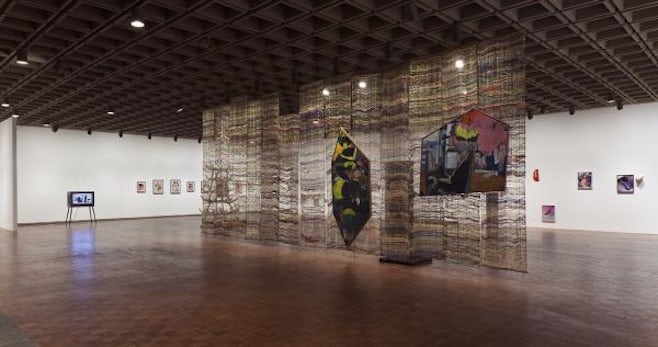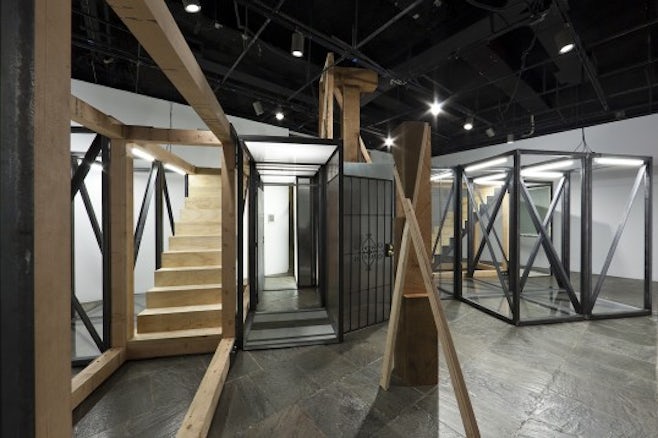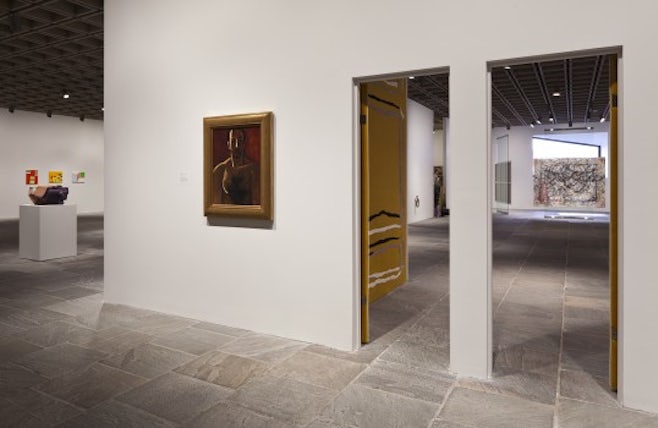
Each Whitney Biennial occurs before the previous one’s forgotten. Each time there is the imperative for change. Among the standouts of the 2010 biennial was Michael Asher’s No Title, which began with the proposal to open the museum to the public 24 hours a day for a week; in practice this was reduced to three days ‘due to budgetary and human resources limitations’.01For those three days, Asher advertised the museum as ‘Open All Day and Nite’ in vinyl lettering across a window of the museum’s Madison Avenue façade. By taking access to the museum as material, Asher’s intervention drew attention to the non-physical, socio-economic operations governing art’s reach. Asher’s piece came to mind when, during the 2012 biennial, it was announced that the museum would close for 24 hours on May Day. Various arts groups affiliated with Occupy launched a fake press release on the counterfeit Whitney website whitney2012.org:
In response to overwhelming demand, the Whitney Museum will close its doors on May 1 so that artists, museum workers and patrons will be able to join the ‘day without the 99%’ and general strike planned for May Day. By taking this action, the Museum acknowledges the labour performed not only by the artists in our exhibitions, but also the labour of everyone who cleans our building; sells tickets and checks coats; guards, handles, maintains and conserves the art; curates and programs our exhibitions; and educates our public. The Museum also respects the wishes of the artists included in the ongoing 2012 Biennial, who have strongly expressed their demand that the museum either cover or remove their works from the exhibition during this time. The Museum supports their call to cease business as usual and to take art into the streets on this historic day.02
The Whitney did close for May Day, but only because it fell on a Tuesday, and the museum is always closed on that weekday. The occupation of a near facsimile of the museum’s official site, and the requests that it launched (to break with corporate sponsors, lower admission prices and allow free entry to one of the building’s floors),03 reflect the salient issues of the recently closed biennial: how inside and outside are constructed, and access and membership negotiated in the museum.
This biennial concerned itself with physical presence in social space. While the majority of the 57 selected artists were represented by works on constant view, many also contributed to an intense performance and moving-image schedule, making for an ever-transforming exhibition. The fourth floor was largely emptied out for the use of five rotating artists-in-residence and the first-floor theatre screened week-long reviews of single artist’s film or video work.04Frequent pilgrimage to the museum was necessary to keep abreast of the daily-changing programme of time-based work, the most extensive to date of any Whitney Biennial. Though there was no pretence that one might see it all, with the Whitney’s day-long entrance fee at $18, to really experience this biennial it made sense to purchase an individual museum membership, covering year-long admission for $85.
Indeed membership, and its development, has been primary to the Whitney since its earliest days. The sculptor and benefactress Gertrude Vanderbilt Whitney started group exhibitions in her private studio in Greenwich Village in 1914, and in 1918 purchased real estate nearby at 147 West 4th Street for the ‘Whitney Studio Club’, to host a coterie of aspiring artists and artist-run exhibitions that eschewed the academy model of a prize-giving jury. 358 artists were included in the first Whitney Annual, with one work each. In 1931 the first Whitney Museum building opened, with an extensive permanent collection of American art; the museum moved around lower Manhattan from one pre-existing building to another, before opting for the patina of permanence, uptown, in naming Marcel Breuer the architect for an original building at 75th and Madison. Three times its former size, this, its present home, was completed in 1966. The 2012 Whitney Biennial was, in fact, the penultimate biennial in the Breuer building; the museum will be moving downtown in 2015, near Chelsea’s galleries, to a building designed to better accommodate new art forms.05
In contrast with the desire to ‘take art into the streets’, Breuer intended that his Whitney Museum ‘should be an independent and self-relying unit … It should transform the vitality of the street into the sincerity and profundity of art.’06 Indeed, the Breuer building as skin became a focal point in this biennial: all the artworks were contained within the museum’s site, making a break with the inclusion of off-site works in the past several biennials.07 The curators for 2012, Jay Sanders and Elisabeth Sussman, prioritised change for museum devotees, through exposure to all kinds of art not readily associated with Breuer’s elegant galleries.

Crossing the short concrete bridge over Breuer’s moat to enter the Whitney Biennial 2012, the construct of inside-outside was manifest just beyond the ticket-taking guards in Oscar Tuazon’s For Hire (2010), which filled the ground-floor’s small gallery. Tuazon’s odd, stuck-together building parts referenced the utility of Modernism’s materials, without the functional follow-through: wooden or metal beams supported a modular sculpture of mismatched linoleum, fibreglass and cheap industrial surfaces, with doors that served not to demarcate interiors but to temporarily block passage through open space. Late in the biennial’s run, For Hire was disassembled and reconfigured on the fourth floor, as the support for a fashion show by K8 Hardy. Hardy’s clothes, photographs and sculptures play exquisite corpse with street fashion. The pair’s collaboration breached the high-art mandate of Breuer’s vision for his building with shrill aggression. The disruption of their commercial materials so contrasted Breuer’s refined, grey structure as to appear alien, drawing attention to what the museum can contain despite itself.

Nick Mauss also installed makeshift architecture upstairs in Concern, Crush, Desire (2010), situated in front of elevators that normally open onto one of Breuer’s designated ‘uncluttered large gallery spaces, interrupted by no columns or beams’.08 Mauss’s theatrical assemblage queried the work of an architect prized for seamlessly melding materials and construction techniques on behalf of Modernism. Directly ahead of the elevator doors, like a blockade, stood a white false wall hung with a Marsden Hartley painting to the left of a set of doors. Should the visitor open the doors to pass through, the other side revealed Mauss’s recreation of the antechamber designed by the near-forgotten fashion and design talent Christian Bérard for Guerlain’s Institut de Beauté on the Champs-Élysées in Paris in 1939. Velvet-covered walls and several pedestals were decked with photographs, works on paper and a small sculpture from the Whitney’s permanent collection: a curation that gathered together little-known works by Andy Warhol, Garry Winogrand, Charles Demuth, Ellsworth Kelly, Eyre de Lanux and May Wilson. Among these an additional piece by Mauss featured a rotation of blurred images projected onto a small, frosted-glass pane. In his contribution to the biennial’s catalogue, titled ‘Don’t Explain Yourself’, he mentions: ‘I never wanted to claim over anything but to find a way to incorporate without assimilating, without forcing to conform. The structure is generally this: one experience is interrupted by the passage into another experience.’09
Mauss offered a late overture to an exhibition mostly populated by artists who contributed to the Breuer galleries as museum-goers, participating in history as made within the museum. For instance, Jutta Koether’s paintings updated Nicolas Poussin’s The Four Seasons (1860–64) with depictions of designer trends and finance charts in fast brushstrokes; these dangled from the ceiling rather than on the wall. Elaine Reichek sampled centuries of historical paintings and texts, adopting the notion of narrative thread from the ancient myth of Ariadne in embroidered works and a tapestry. Moyra Davey displayed her photographs of Mary Wollstonecraft’s letters as preserved documents: gathered for display after having been mailed to women in her family, they evidenced their physical effacement from circulation. Richard Hawkins’s paintings, contemporary re-stagings of Gustave Moreau’s Salomé Dancing Before Herod (1876), were interspersed along a lengthy frieze-arrangement with his paper collages of Western images, in turn based on the butoh-fu notebooks of choreographer Tatsumi Hijikata. A placard offered Werner Herzog’s thoughts on his choice of the etchings of the Dutch artist Hercules Segers (c.1589/90–c.1633–38) as the subject of his video installation Hearsay of the Soul (2012): ‘the father of modernity in art … his work creates an illumination inside of us, and we instantly know that this is not a factual truth but an ecstatic one’.
What inclusion within the museum might confer came to the fore in Robert Gober’s curatorial artwork for this biennial, his installation of the transcendental paintings of Forrest Bess (1911–77) in one of Breuer’s smaller galleries. Bess is remembered as an eccentric and tragic rural Texan painter whose intimately scaled abstractions were shown during his lifetime at the Betty Parsons Gallery in New York. Gober’s selection, however, added a new dimension to Bess’s work by showing documentation of his self-performed surgery to become a hermaphrodite, which Parsons had refused to show alongside his paintings. Rather than wrangling with Breuer’s equation of museum and ziggurat, where art is redeemed from the realm of commerce, Gober took up the museum as safe-haven for historical constructions to naturalise a new persona for Bess within the art world. He enacted the museum building’s capacity as a vessel for the change that has occurred in art’s discourse since the mid-twentieth century, to more widely encompass non-normative sexuality.10

The artist Wu Tsang similarly appropriated a building, but of far different trappings, to consider access and belonging in relation to art’s purview, as complicated by the politics of gender, race and economics. The creative and social history vessel in which this transgender Asian-American artist takes refuge is an LGBT, immigrant-safe club in Los Angeles, the Silver Platter. In his documentary video Wildness (2012), screened as part of the film and video programme, Tsang recounts how he found a spiritual home in the Silver Platter and began to organise a ‘performance party’ there, ‘Wildness’, with a group of artist-deejay friends. As the event’s notoriety spread – Tsang’s camera courses over average white guys and other new onlookers – the club’s existence as a ‘safe space’ becomes questionable. The building as other, as a space for projection and imagined dialogue, is the material through which Wildness documents Tsang’s changing performative persona, as club promoter, legal aid activist and artist, amidst a creative community physically vulnerable to both violence and deportation outside the Silver Platter. Tsang’s work speaks for the unpredictable forms that art can take in a space, and wreak on it, and it insists on the right to privacy and limited access. On the fourth floor of the Whitney building, Tsang furnished two rooms like a nightclub’s dressing rooms, with leather couches, mirrors and footage of the Silver Platter on monitors, for the installation Green Room (2012). These were utilised as private spaces for the performers in the adjacent gallery to escape to; only when they didn’t need them were museum-goers allowed entry.

Keeping everyone out was explicitly the point of Mike Kelley’s Mobile Homestead (2005–2012). The first-floor theatre screened video documentation of this project, for which Kelley had an exact, but mobile, replica of his childhood home built, to be alternately used as a community gallery or transported as a public service centre; beneath the housing unit’s resting spot at the Detroit’s Museum of Contemporary Art, however, Kelley designed a private tunnel space only available for activities of his choosing, open to specific individuals at his invitation. The video documentation shows the house being driven away from the museum and through the city on a tractor-trail bed, making a stop as a soup kitchen, set to a soundtrack of live performances by local musicians of various ethnicities and affinities. The impervious façade of the suburban ranch house is borne past the drastically varied streets of a struggling city – a haunting travesty of the notion that museum art can come to the streets. As Kelley noted: ‘I have a deep distrust of art that is foisted upon the public; I prefer that people go and see art if they choose to do so. […] But, perhaps, the failure of the Mobile Homestead project now, after being filtered through the institutions of the art world and community services, is successful as a model of my own belief that public art is always doomed to failure because of its basic passive/aggressive nature.’11

Such an attitude might be read in the title for Dawn Kasper’s This Could Be Sometihng if I Let It (2012), a performance in which she treated her private artistic space as literally as Kelly did, and also located it at the museum rather than taking it to the streets. The work admitted to the pressure on both artist and audience in stepping foot in the museum to create meaning. She moved her home/studio, the mess of all her worldly belongings, into a room-sized gallery allotted to her, and inhabited it for the opening hours of the museum throughout the duration of the biennial. She occupied the museum as authorised, and became the only artist to be individually pinpointed in the counterfeit May Day press release at www.whitney2012.org:
…invitation to an individual artist to live in the Museum for the duration of the Biennial … is a far too limited, perfunctory attempt at merging art and life. Rather than provide special accommodations to just a single individual, the Museum will now also offer up the fourth-floor performance space as a cultural commons available to all, creating a space for collaboration, performance, organising and creative reuse where public, nonhierarchical, radically democratic groups can freely gather.
Should achieving total access be the desired endpoint, perhaps there can be no more Whitney Biennials, an event that selects insiders. With two years still to go, the Arts & Labor group of Occupy in New York have already proposed an extreme intervention for the next biennial, in their recent statement ‘End the Whitney Biennial 2014’: ‘We therefore call upon the Whitney to terminate its collusion with this system of injustice and use its resources to imagine sustainable models of creativity and culture that are accessible not just to Americans but to people around the globe.’12 Yet the unexpected presence of Occupy was an aberrance that accidentally fulfilled the 2012 biennial curators’ effort, as discussed in their conversation in the catalogue, to call in artists who would ‘show up and create a live, unpredictable scenario. Which, in a way, is the whole Biennial.’13 Sanders and Sussman risked seeming old-fashioned in their total commitment to the Breuer building as the 2012 biennial’s site, and in their selection of so many inward-looking artists, but the exhibition became timely through its openness to immediate events. The participation of Occupy added forward-momentum. Chances are the next Biennial will happen, founded in desire for another intervention in getting in.
Footnotes
-
See http://whitney.org/Events/MichaelAsher (last accessed on 7 July 2012)
-
See ‘Whitney Museum to Close for May Day; Announces Governance Changes, Special Addition to 2012 Biennial Programming’, http://whitney2012.org/Press/Archive/may_closing_release.html. The contributing Occupy-affiliated groups have been named as Arts & Labor, Occupy Museums and Arts & Culture, see http://blogs.artinfo.com/artintheair/2012/04/23/occupy-wall-streets-fake-whitney-press-release-announces-post-may-day-restructuring/ (both last accessed on 7 July 2012).
-
‘The Museum expects to reopen on May 2 a wholly changed institution. This transformation began when we made the difficult decision to break with two of our main corporate sponsors, Sotheby’s and Deutsche Bank, on the eve of the opening of the 2012 Biennial […] And because of the importance of making multiple visits to the Museum to view all of the time-based work included in the 2012 Biennial, and the desire to make this work more accessible to audiences of all kinds, the Museum is also committed to lowering its admission price and offering free entry to the performance floor for the duration of the exhibition.’ See ‘Whitney Museum to Close for May Day’, op. cit. The museum was unresponsive to the institutional changes suggested.
-
Thomas Beard and Ed Halter of Light Industry in Brooklyn curated the screening programme.
-
Renzo Piano is the new building’s architect; it will be located in the Meatpacking District, on Gansevoort Street, at the foot of the High Line. See http://www.whitney.org/About/NewBuilding/About. Breuer’s uptown landmark will be leased to the Metropolitan Museum of Art, for its modern and contemporary art holdings. See Carol Vogel, ‘Met Plans to Occupy the Whitney’s Uptown Site’, The New York Times, 11 May 2011, available at http://www.nytimes.com/2011/05/12/arts/design/the-met-to-take-over-whitneys-breuer-building.html?pagewanted=all. Interestingly, Gertrude Vanderbilt Whitney made the decision to open a museum after the Met rejected her donation of an endowment in 1929. See http://whitney.org/About/History (all last accessed on 7 July 2012).
-
Marcel Breuer, ‘Comments at the Presentation of the Design of the Whitney Museum Project to the Museum’s Board of Trustees, 12 November 1963’, in Ezra Stoller, Whitney Museum of American Art, New York: Princeton Architectural Press, 2000, p.83.
-
Previous biennials, for example, installed works in the nearby Amory building or Central Park. While artworks’ presence on-site was stressed in 2012 (Red Crayola’s members were embodied in a computer monitor, interacting with museum visitors via Scype, for example), Artists Space collaborated with the Whitney in hosting a series of talks on the biennial at its Soho space. It should be noted that Vincent Gallo submitted six photographic portraits of himself to the exhibition catalogue, but failed to ever be present in the Whitney building itself: he did not show a film or other work in the biennial’s run, suggesting his absence from the building was his contribution. See Dennis Lim, ‘R.I.P. “Promises”, It Was Nice Knowing You: Vincent Gallo Keeps “Promises Written in Water” Off Screens’, The New York Times, 8 June 2012, available at http://www.nytimes.com/2012/06/10/movies/vincent-gallo-keeps-promises-written-in-water-off-screens.html?_r=1 (last accessed on 10 June 2012).
-
M. Breuer, ‘Comments at the Presentation of the Design of the Whitney Museum’, op. cit.
-
Nick Mauss, ‘Don’t Explain Yourself’, in Jay Sanders and Elisabeth Sussman (ed.), The Whitney Biennial 2010 (exh. cat.), New York: The Whitney Museum of Modern Art, 2010, p.208.
-
Nick Mauss, ‘Don’t Explain Yourself’, in Jay Sanders and Elisabeth Sussman (ed.), The Whitney Biennial 2010 (exh. cat.), New York: The Whitney Museum of Modern Art, 2010, p.208.
-
And Gober allows that Parsons’s curation of Bess was simply another take to his: the vitrine of assembled documents was equally devoted to Parsons’s start in the art world as a painter, her discovery of Bess and her fidelity to him.
-
Mike Kelley, ‘Mobile Homestead’, in J. Sanders and E. Sussman (ed.), The Whitney Biennial 2010, op. cit., p.11.
-
Arts & Labor, ‘End the Whitney Biennial 2014’, available at http://artsandlabor.org/end-the-whitney-biennial-2014/ (last accessed on 7 July 2012).
